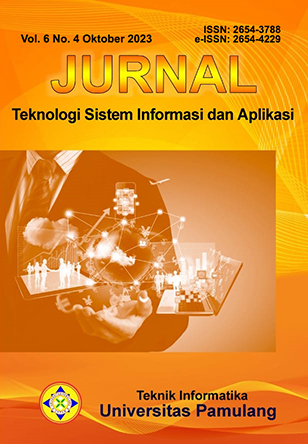Perancangan Sistem Informasi Penjualan Berbasis Web di PT. MARKTEL
Kata Kunci:
Information system, Sales, Waterfall, PHP, MySQLAbstrak
Information systems are needed in every company to facilitate fast and accurate data processing. One of them is a sales information system currently used at PT. MARKTEL still has processes that have not been computerized. To meet these information needs, especially to deal with data processing problems, report generation and systems that have not worked as expected, companies need a computer-based information system. The system development method in this study uses the waterfall method which has a systematic and clear flow so that the system development is more detailed. The waterfall method is a structured modeling-based method consisting of Flowmaps, Context Diagrams, Level 0 Data Flow Diagrams (DFD) and Entity Relationship Diagrams (ERD). In designing and implementing the program, the author uses the PHP programming language with MySQL database. The existence of a web-based sales information system at PT.MARKTEL is expected to simplify and speed up data processing and report generation and can minimize errors so that company goals can be achieved optimally.
Referensi
Abdussalaam, F., & Badriansyah, B. (2021). Perancangan Sistem Informasi Pemeriksaan Barang Berbasis Web Menggunakan Metode SSAD. Expert, 11(2), 174-183.
Abdussalaam, F., & Ramdani, A. (2022). Perancangan Sitem Informasi Manajemen Praktek Kerja Lapangan Berbasis Web Menggunakan Metode Agile. INFOKOM (Informatika & Komputer), 10(2), 33-43.
Erawati, W. (2019). Perancangan Sistem Informasi Penjualan Dengan Pendekatan Metode Waterfall. Jurnal Media Informatika Budidarma, 3(1), 1-8.
Kelvin, S. (2020). Studi Efisiensi Sumber Daya Terhadap Efektivitas Penggunaan Database: Studi kasus SQL Server Dan MySQL. Conference on Business, Social Scienes and Innovation Technology, 1(1), 508-515.
Muliadi, M., Andriani, M., & Irawan, H. (2020). Perancangan Sistem Informasi Pemesanan Kamar Hotel Berbasis Website (Web) Menggunakan Data Flow Diagram. JISI: Jurnal Integrasi Sistem Industri, 7(2), 111-122.
Muqorobin, A., & Fahmi, A. S. (2020). Model jual beli kredit (angsuran) pada Lembaga Keuangan Islam Non-Bank (Studi Kasus di Lembaga Keuangan Islam Non-Bank Kota Ponorogo. Al Tijarah, 6(2), 118-119.
Nur, H. (2019). Penggunaan Metode Waterfall Dalam Rancang Bangun Sistem Informasi Penjualan. Generation Journal, 3(1), 1-10.
Qomariah, L., & Sucipto, A. (2021). Sistem Infomasi Surat Perintah Tugas Menggunakan Pendekatan Web Engineering. Jurnal Teknologi dan Sistem Informasi, 2(1), 86-95.
Rani, R. N., Tina, T. Y., Karyadi, & Abdussalaam, F. (2022). Perancangan Sistem Informasi Akuntansi Penjualan Obat Menggunakan Microsoft Visual Studio 2010 di Klinik Utama Bunda Nand. Fair Value: Jurnal Ilmiah Akuntansi dan Keuangan, 4(4), 1968-1980.
Retno, S., Hasdyna, N., Mutasar, M., & Dinata, R. K. (2020). Algoritma Honey Encryption dalam Sistem Pendataan Sertifikat Tanah dan Bangunan di Universitas Malikussaleh. INFORMAL: Informatics Journal, 5(3), 87-95.
Safwandi, S. (2021). Analisis Perancangan Sistem Informasi Sekolah Menengah Kejuruan 1 Gandapura Dengan Model Diagram Konteks dan Data Flow Diagram. Jurnal Teknologi Terapan dan Sains 4.0, 2(2), 525-539.
Syakurrahman, M., & Noviana, R. (2022). Pembuatan Web Untuk Seleksi Calon Karyawan PT. ASCLAR Indonesia Menggunakan PHP dan MySQL. Jurnal Ilmiah Komputasi, 21(4), 603-606.
Vikasari, C. (2018). Pengujian Sistem Informasi Magang Industri Dengan Metode Blackbox Testing Boundary Value Analysis. SYNTAX Jurnal Informatika, 7(1), 44-51.
Wahono, S., & Ali, H. (2021). Peranan Data Warehouse, Software Dan Brainware Terhadap Pengambilan Keputusan (Literature Review Executive Support Sistem for Business). Jurnal Ekonomi Manajemen Sistem Informasi, 3(2), 225-239.
Wijaya, Y. D., & Astuti, M. W. (2021). Pengujian Blackbox Sistem Informasi Penilaian Kinerja Karyawan PT. Inka (Persero) Berbasis Equivalence Partitions. Jurnal Digital Teknologi Informasi, 4(1), 22-26.
Unduhan
Diterbitkan
Cara Mengutip
Terbitan
Bagian
Lisensi
Hak Cipta (c) 2023 Olivia Putri Anggraeni, Karyadi, Falaah Abdussalaam

Artikel ini berlisensi Creative Commons Attribution-NonCommercial 4.0 International License.
Authors who publish with this journal agree to the following terms:
- Authors retain copyright and grant the journal right of first publication with the work simultaneously licensed under a Creative Commons Attribution License that allows others to share the work with an acknowledgement of the work's authorship and initial publication in this journal.
- Authors are able to enter into separate, additional contractual arrangements for the non-exclusive distribution of the journal's published version of the work (e.g., post it to an institutional repository or publish it in a book), with an acknowledgement of its initial publication in this journal.
- Authors are permitted and encouraged to post their work online (e.g., in institutional repositories or on their website) prior to and during the submission process, as it can lead to productive exchanges, as well as earlier and greater citation of published work (See The Effect of Open Access).
Jurnal Teknologi Sistem Informasi dan Aplikasi have CC BY-NC or an equivalent license as the optimal license for the publication, distribution, use, and reuse of scholarly work.
In developing strategy and setting priorities, Jurnal Teknologi Sistem Informasi dan Aplikasi recognize that free access is better than priced access, libre access is better than free access, and libre under CC BY-NC or the equivalent is better than libre under more restrictive open licenses. We should achieve what we can when we can. We should not delay achieving free in order to achieve libre, and we should not stop with free when we can achieve libre.
This work is licensed under a Creative Commons Attribution-NonCommercial 4.0 International (CC BY-NC 4.0) License
YOU ARE FREE TO:
- Share - copy and redistribute the material in any medium or format
- Adapt - remix, transform, and build upon the material for any purpose, even commercially.
- The licensor cannot revoke these freedoms as long as you follow the license terms



_2020_-_7(2)_2024_-_Thumbnail.png)












